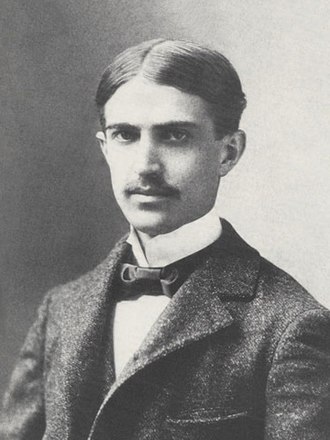 "When the prophet, a complacent fat man,
"When the prophet, a complacent fat man,
Arrived at the mountain-top,
He cried: "Woe to my knowledge!
I intended to see good white lands
And bad black lands,
But the scene is grey."
I read through all the poetry books in my high school library-- all two or three shelves of them. I found here Catullus, modern American poets, Langston Hughes, and the children's poetry of Lillian Morrison. But it was Stephen Crane's poems that most impacted me.
They are not poems of feeling. They have no lush beautiful words. They are direct and sparse with an intellectual punch. They are poems that comment on human frailty, both institutional and personal.
They are not poems of feeling. They have no lush beautiful words. They are direct and sparse with an intellectual punch. They are poems that comment on human frailty, both institutional and personal.
A learned man came to me once.
He
said, "I know the way, -- come."
And I was overjoyed at this.
Together we hastened.
Soon, too soon, we were
Where my eyes were useless,
And I knew not the ways of my feet.
I clung to the hand of my friend;
But at last he cried, "I am lost."
I learned that we should question those who claim to be on the inside track, who claim to know the truth. Don't just follow the crowd. Mom used to ask me, "If all the girls were jumping off the roof, would you want to do it too?"
And I was overjoyed at this.
Together we hastened.
Soon, too soon, we were
Where my eyes were useless,
And I knew not the ways of my feet.
I clung to the hand of my friend;
But at last he cried, "I am lost."
I learned that we should question those who claim to be on the inside track, who claim to know the truth. Don't just follow the crowd. Mom used to ask me, "If all the girls were jumping off the roof, would you want to do it too?"
"Think as I think," said a
man,
"Or you are abominably wicked;
You are a toad."
And after I had thought of it,
I said, "I will, then, be a toad."
Thinking for oneself is not popular. Some governments and churches don't even allow it. Galileo, Copernicus, and Darwin each suffered for promoting scientific evidence that conflicted with prevailing thought.
There was crimson clash of war.
You are a toad."
And after I had thought of it,
I said, "I will, then, be a toad."
Thinking for oneself is not popular. Some governments and churches don't even allow it. Galileo, Copernicus, and Darwin each suffered for promoting scientific evidence that conflicted with prevailing thought.
There was crimson clash of war.
Lands
turned black and bare;
Women wept;
Babes ran, wondering.
There came one who understood not these things.
He said, "Why is this?"
Whereupon a million strove to answer him.
There was such intricate clamour of tongues,
That still the reason was not.
Women wept;
Babes ran, wondering.
There came one who understood not these things.
He said, "Why is this?"
Whereupon a million strove to answer him.
There was such intricate clamour of tongues,
That still the reason was not.
After all, what is TRUTH? Who knows the truth? Is it not subjective, changed by one's culture, one's faith, one's experience? Can we ever really know The Truth?
"Truth," said a traveler,
"Is a rock, a mighty fortress;
Often have I been to it,
Even to its highest tower,
From whence the world looks black."
"Truth," said a traveller,
"Is a breath, a wind,
A shadow, a phantom;
Long have I pursued it,
But never have I touched
The hem of its garment."
"Is a rock, a mighty fortress;
Often have I been to it,
Even to its highest tower,
From whence the world looks black."
"Truth," said a traveller,
"Is a breath, a wind,
A shadow, a phantom;
Long have I pursued it,
But never have I touched
The hem of its garment."
And I believed the second traveller;
For truth was to me
A breath, a wind,
A shadow, a phantom,
And never had I touched
The hem of its garment.
For truth was to me
A breath, a wind,
A shadow, a phantom,
And never had I touched
The hem of its garment.
And yet we humans relentless pursue the elusive butterfly of truth, sure we will demonstrate the only, the one, the ultimate certainty.
I saw a man pursuing the horizon;
Round and round they sped.
I was disturbed at this;
I accosted the man.
"It is futile," I said,
"You can never -- "
"You lie," he cried,
And ran on.
Round and round they sped.
I was disturbed at this;
I accosted the man.
"It is futile," I said,
"You can never -- "
"You lie," he cried,
And ran on.
Ever notice how people do not change their views no matter what? We hold on our opinions to the bitter end.
In the desert
I saw a creature, naked, bestial,
Who, squatting upon the ground,
Held his heart in his hands,
And ate of it.
I said: "Is it good, friend?"
"It is bitter-bitter," he answered;
"But I like it
Because it is bitter,
And because it is my heart."
I saw a creature, naked, bestial,
Who, squatting upon the ground,
Held his heart in his hands,
And ate of it.
I said: "Is it good, friend?"
"It is bitter-bitter," he answered;
"But I like it
Because it is bitter,
And because it is my heart."
Well, that is one way of looking at the human experience.
Crane's poems taught to think for oneself, but at the same time warns not to cling unthinkingly to one's own opinions. We live in a complicated world.



































